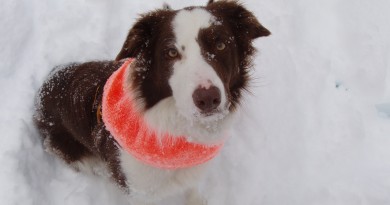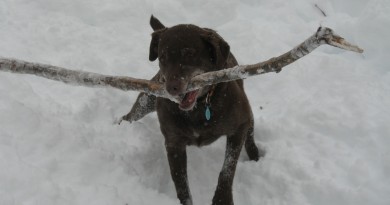Canine Chiropractic: Another Kind of “Treat”-ment
By
Kelly Rybicki
Posted April 1st, 2008
Most of us have either been to a chiropractor or know someone who has, for the treatment of back and neck pain. In fact, chiropractic is regarded as one of the most effective treatments for uncomplicated back pain. But have you ever thought about your dog’s own back? Dogs can have back pain just like we do. Animal chiropractic is an expanding natural approach for treatment of back, neck, hip, and elbow problems, as well as arthritis or degenerative changes in these areas.
The word chiropractic derives from the Greek word cheira (by the hand) and praktikos (practice). Manipulation of the spine dates back to ancient China and Rome. Almost all civilizations around the world have had manipulation as part of their culture. In Europe there still are practicing artisans, who are called “bone setters.” Their roots go back to Medieval European spinal manipulators. Modern chiropractic, as a profession, dates back to 1895, with David Daniel Palmer accredited as its founder. As early as 1920, D.D. Palmer taught a course in animal chiropractic, awarding his students a Doctor of Chiropractic Veterinary diploma.
So what is it that doggie chiropractic can treat? Chiropractic treats spinal and extremity “subluxations,” or joint restrictions. Subluxations are abnormal or restricted movements in the spine or extremities, often displayed as joint misalignments. This change in the normal motion of the spinal segments (vertebrae) is treated by using specific, well-controlled movements to release and realign the malpositioned vertebrae or joint.
When a subluxation occurs, the spine or extremity joint can lose its flexibility, muscle coordination, and range of motion. Hence, dogs with subluxations can have these problems: neck, midback, low back, or pelvis pain/discomfort; spine and hip stiffness; lameness in the front or hind end; dragging of a hind leg; running/trotting “off-kilter”; muscle spasms in the back or neck; difficulty walking straight; difficulty going up/down stairs, climbing into the car, or getting onto the bed/couch; and even organ dysfunction associated with musculoskeletal complaints.
All of the dog’s body parts receive nerve signals from the spine and brain. Therefore, if innervation to an organ is disrupted by a subluxation, the function of that organ can be affected. This is the possible connection between organ dysfunction (say, bladder problems) and spinal subluxations.
What causes these subluxations in Fido? According to Dr. Daniel Karmen, DC, in The Well Adjusted Dog, the improper use of collars is the number one cause of neck subluxations. The four main types of collars—the flat collar, the choke collar, the prong collar, and the harness all have possible associated problems. However, the problem lies primarily in the handler’s use of the collar and lead when walking the dog. In particular, jerking the dog’s head up for correction is often a big culprit for upper cervical (neck) subluxations in the dog. Upper neck subluxations are especially a health hazard to dogs as this is the point at which the body and brain meet. All nerve conductions from the brain stem pass through this area on the way down the spinal cord, thereby transmitting important spinal transmissions to the rest of the body.
Several other causes of subluxations or joint restrictions in dogs exist. Obesity and deconditioned dogs are major problems, not only on a dog’s constitutional system but to the musculoskeletal system as well. Obesity exerts increased pressure or pull on the spine. Just as undesirable as inactivity, overexertion injuries with play or exercise, especially when the dog is out of shape, can easily move vertebrae out of alignment or cause muscle spasms. Dogs who spend much of their time crated are also prime candidates for joint problems due to non-movement of the joints (immobility equals death to our joints). Fleas! A dog’s scratching in awkward positions to get those pesky critters can cause subluxations in the neck and back.
Today, animal chiropractic is performed either by chiropractors
with additional training in canine and equine manipulation and soft
tissue techniques, or by veterinarians who have specialized training in chiropractic techniques. It must be noted that according to Vermont law, a veterinarian must refer patients to chiropractors, and there should be cooperation with the chiropractor and referring vet for the health and safety of the pet involved. Often, dual intervention by the animal chiropractor and the vet using both manipulation and anti-inflammatory medications needs to be considered.
Chiropractic care has tremendous potential for improving the
quality of life and reducing pain symptoms in the furry, beloved
members of our family. Chiropractic holds the potential to bring back or improve your dog’s ability to take walks with less pain, to be able to walk longer, to get up from lying with a smile rather than a groan, and most importantly to live a better quality of life. Just as we’d all like to have for ourselves.


